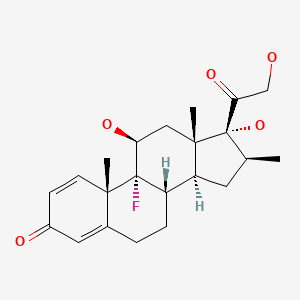Attribution Statement: LactMed is a registered trademark of the U.S. Department of Health and Human Services.
NCBI Bookshelf. A service of the National Library of Medicine, National Institutes of Health.
Drugs and Lactation Database (LactMed®) [Internet]. Bethesda (MD): National Institute of Child Health and Human Development; 2006-.
CASRN: 378-44-9

Drug Levels and Effects
Summary of Use during Lactation
Betamethasone has not been well studied during breastfeeding. Systemic betamethasone is best avoided in favor of one of the shorter-acting and better studied alternatives because of its potency and low protein binding which would favor its passage into milk. Use of betamethasone 3 to 9 days prior to delivery of a preterm infant might decrease postpartum milk production in some women. Local injections, such as for tendinitis, would not be expected to cause any adverse effects in breastfed infants,[1] but might occasionally cause temporary loss of milk supply. See also Betamethasone, Topical.
Drug Levels
Maternal Levels. Relevant published information was not found as of the revision date.
Infant Levels. Relevant published information was not found as of the revision date.
Effects in Breastfed Infants
None reported with any corticosteroid.
Effects on Lactation and Breastmilk
A 5.7 mg dose of depot betamethasone injected into the shoulder for bursitis had no effect in the milk supply in one mother.[2] However, medium to large doses of depot corticosteroids injected into joints have been reported to cause temporary reduction of lactation.[2,3]
A double-blind study in the 1970s randomized pregnant women in preterm labor to either 6 mg of short-acting betamethasone phosphate plus 6 mg long-acting betamethasone acetate or a control treatment containing 6 mg cortisone acetate. Later in the trial, the doses were doubled because of an incomplete response. A total of 560 women received betamethasone and 582 received cortisone. No difference was seen in the percentage of women lactating at hospital discharge (32% and 30.5%, respectively); however, these percentages are very low compared to the rates in many hospitals today.[4]
A study of 46 women who delivered an infant before 34 weeks of gestation found that a course of betamethasone (2 intramuscular injections of 11.4 mg of betamethasone 24 hours apart) given between 3 and 9 days before delivery resulted in delayed lactogenesis II and lower average milk volumes during the 10 days after delivery. Milk volume was not affected if the infant was delivered less than 3 days or more than 10 days after the mother received the corticosteroid.[5]
A study of 87 pregnant women found that betamethasone given as above during pregnancy caused a premature stimulation of lactose secretion during pregnancy. Although the increase was statistically significant, the clinical importance appears to be minimal.[6]
Alternate Drugs to Consider
(Systemic) Methylprednisolone, Prednisolone, Prednisone
References
- 1.
- Schned ES. DeQuervain tenosynovitis in pregnant and postpartum women. Obstet Gynecol. 1986;68:411–4. [PubMed: 3488531]
- 2.
- McGuire E. Sudden loss of milk supply following high-dose triamcinolone (Kenacort) injection. Breastfeed Rev. 2012;20:32–4. [PubMed: 22724311]
- 3.
- Babwah TJ, Nunes P, Maharaj RG. An unexpected temporary suppression of lactation after a local corticosteroid injection for tenosynovitis. Eur J Gen Pract. 2013;19:248–50. [PubMed: 24261425]
- 4.
- Walters AGB, Lin L, Crowther CA, et al. Betamethasone for preterm birth: Auckland Steroid Trial full results and new insights 50 years on. J Pediatr. 2022;255:80–8. [PubMed: 36336005]
- 5.
- Henderson JJ, Hartmann PE, Newnham JP, et al. Effect of preterm birth and antenatal corticosteroid treatment on lactogenesis II in women. Pediatrics. 2008;121:e92–100. [PubMed: 18166549]
- 6.
- Henderson JJ, Newnham JP, Simmer K, et al. Effects of antenatal corticosteroids on urinary markers of the initiation of lactation in pregnant women. Breastfeed Med. 2009;4:201–6. [PubMed: 19772378]
Substance Identification
Substance Name
Betamethasone
CAS Registry Number
378-44-9
Drug Class
Breast Feeding
Lactation
Milk, Human
Corticosteroids, Systemic
Glucocorticoids
Anti-Inflammatory Agents
Disclaimer: Information presented in this database is not meant as a substitute for professional judgment. You should consult your healthcare provider for breastfeeding advice related to your particular situation. The U.S. government does not warrant or assume any liability or responsibility for the accuracy or completeness of the information on this Site.
- User and Medical Advice Disclaimer
- Drugs and Lactation Database (LactMed) - Record Format
- LactMed - Database Creation and Peer Review Process
- Fact Sheet. Drugs and Lactation Database (LactMed)
- Drugs and Lactation Database (LactMed) - Glossary
- LactMed Selected References
- Drugs and Lactation Database (LactMed) - About Dietary Supplements
- Breastfeeding Links
- PubChem SubstanceRelated PubChem Substances
- PubMedLinks to PubMed
- Review Betamethasone, Topical.[Drugs and Lactation Database (...]Review Betamethasone, Topical.. Drugs and Lactation Database (LactMed®). 2006
- Review Dexamethasone, Topical.[Drugs and Lactation Database (...]Review Dexamethasone, Topical.. Drugs and Lactation Database (LactMed®). 2006
- Review Dexamethasone.[Drugs and Lactation Database (...]Review Dexamethasone.. Drugs and Lactation Database (LactMed®). 2006
- Review Triamcinolone, Topical.[Drugs and Lactation Database (...]Review Triamcinolone, Topical.. Drugs and Lactation Database (LactMed®). 2006
- Review Fluorometholone.[Drugs and Lactation Database (...]Review Fluorometholone.. Drugs and Lactation Database (LactMed®). 2006
- Betamethasone - Drugs and Lactation Database (LactMed®)Betamethasone - Drugs and Lactation Database (LactMed®)
Your browsing activity is empty.
Activity recording is turned off.
See more...
